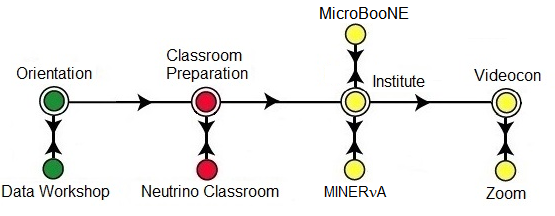Navigation
- Neutrino Masterclass Project Map
- Online tools
- Start of masterclass day
- Shift training
- Data analysis
- Understanding results

First things: prepare ahead
Each computer should have robust internet access. Two students should work together at each computer to complete a 50 events dataset. Before the masterclass, mentors, tutors, and teachers should:
- Schedule and participate in an online Orientation.
- Review the MicroBooNE Masterclass Documentation.
- Try out the measurement. Use the Practice Datasets and Practice Spreadsheet.
- Prepare a presentation covering the following:
- Standard Model with stress on neutrinos
- MicroBooNE and the Liquid Argon TPC
- Instrumentation physics, especially commissioning and calibration
- Review the MicroBooNE Masterclass Measurement slides (to be released soon).
- Go over all the steps in this page.
- Prepare and test your Zoom connection.
Students arrive
This should occupy the first 30-60 min
- Registration: please have students sign in on a registration sheet with name, school, and teacher.
- Gateway experience: have a cloud chamber, e/m apparatus, or something similar to whet interest
- Ice-breaker activity: students in small inhomogeneous groups create 1-2 good questions about particle physics, neutrinos, MINERvA, and/or DUNE.
Shift training
Get students ready for their data analysis shift! This will take about 3 hours, though parts of it can be moved to other times of the day.
Mentor presentation, 30-60 min:
- keep it interactive - ask questions about prior experience, shows of hands, wild guesses, etc.
- give students something to touch, e.g. a wave-shifting fiber
- connect to classroom prep
- touch on standard model
- talk about your research
- Focus on theme of the MicroBooNE neutrino detector commissioning masterclass: use of cosmic ray muons to test and calibrate the Liquid Argon TPC both for the MicroBooNE experiment and to develop the technology for DUNE..
Tour, 30-60 min:
- adds much to the day - often most popular part
- if you have an accelerator to show, great!
- if not: any interesting labs, even if not particle physics, are still great
- have enthusiastic grad students around to chat and explain
Analysis Prep (30-60 min):
- Have a teacher lead this if practical.
- Use/adapt the MicroBooNE Masterclass Measurment slides.
- Important: go through "masterclass-samples" in ARGO on the projector with the students:
- Show students how to navigate to a data file.
- Discuss how to use the tools in ARGO.
- Discuss each event in terms of:
- How the signal from a track drifts to the wires.
- Appropriate vertical distance for drift velocity calculation.
- Measurement of decay of muon tracks to find "liftetime" - stress that this is not the natural muon lifetime of 2.2 μsec but the "electron drift lifetime" - the lietime of the electron signal drifting through the liquid argon from a point on the muon track to the anode.
- Copying kinematic data to the spreadsheet.
- What we plan to do with the recorded data.
Lunch with a Physicist (30-60 min):
- This is also very popular and a great way for students to interact and get comfortable with scientists.
Data Analysis
This is the heart of the masterclass and takes about 60 min. There should be 2 students at each computer, cooperating to get their data measured. Mentors, tutors, and teachers should circulate to help the students analyze the events and work out any problems they have. Don't give them answers. Help them figure things out and learn to see data as scientist does.
- Instructional Screencast
- Cheat Sheet
Data Assiignments (subject to change):
International Masterclasses
| Date/time CT | Institute (Data Group) | Institute (Data Group) | Institute (Data) | Spreadsheet |
|---|---|---|---|---|
| TBD | ||||
If >50 students are expected, contact Masterclass Coordination for more data groups.
Sharing Results
This takes a little over one hour. Both parts are important.
Discussion (30-45 min):
- Mentor leads, students interact.
- Look at combined plots for your institute in spreadsheet.
- Help students analyze histograms to find:
- Average drift velocity of electrons
- Electron drift lifetime
- Estimate of argon purity from electron drift lifetime measurement
- Discuss meaning of result for understanding the performance of the detector.
Videoconference (30-45 min):
Connecting to videoconferences:
Course of a videoconference:
- Connect to videoconference link or Indico page (see above).
- Someone should log into the videoconference 15 min early to be sure the connection is established. See the Schedules page.
- Follow the agenda on Indico:
- Introductions and warm-up
- Institute results
- Combined results
- Discussion, Q&A, and wrap-up
- It is good to have a student spokesperson but try to arrange so it is not too hard for another student to make a comment or ask a question.
After this, we have post-discussion and closeout.
Before you go home:
Please report your attendance numbers on our Attendance Form!
We ask teachers, tutors, and mentors to fill out a short survey within a day or two after the masterclass.
Have a great day!
